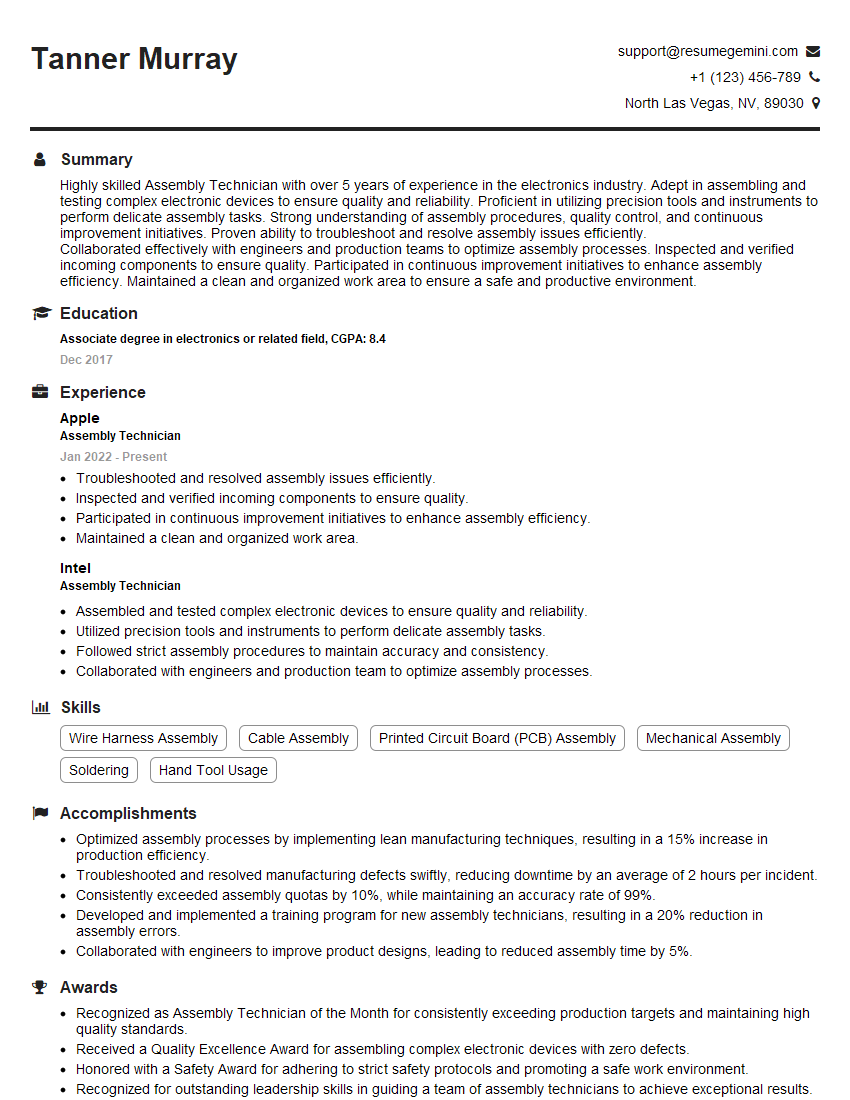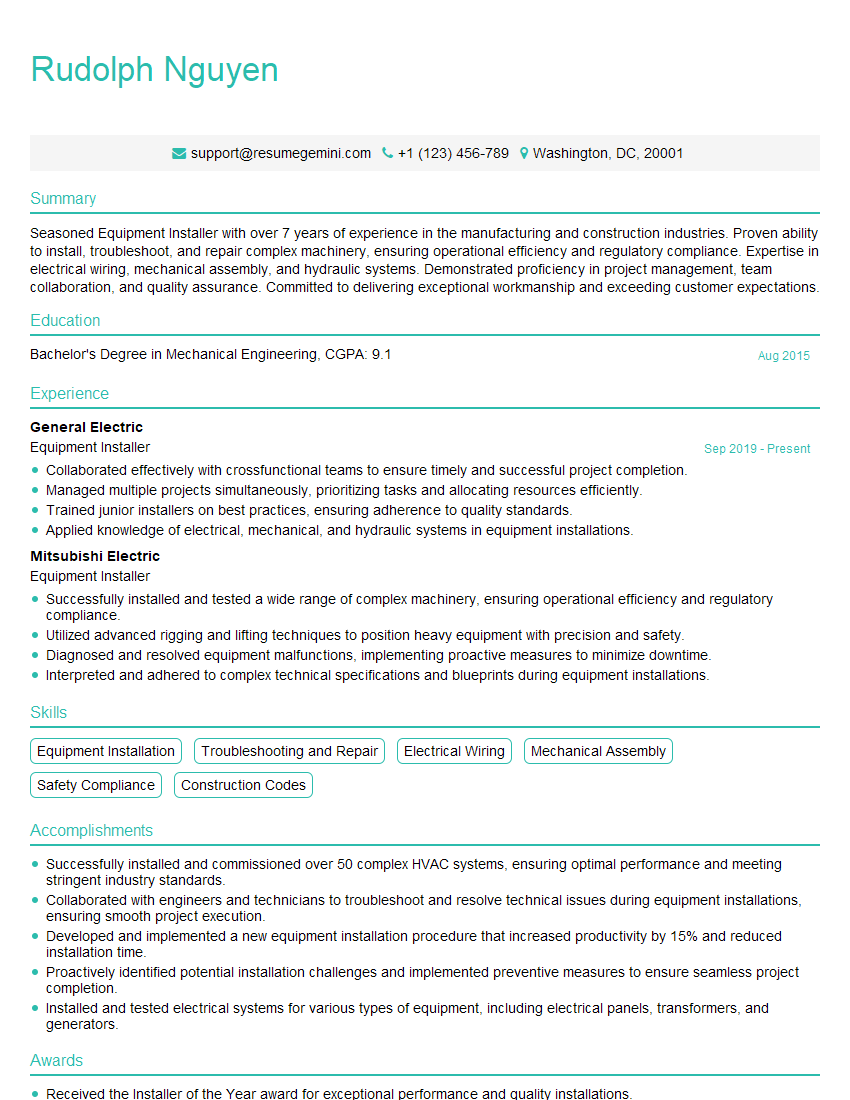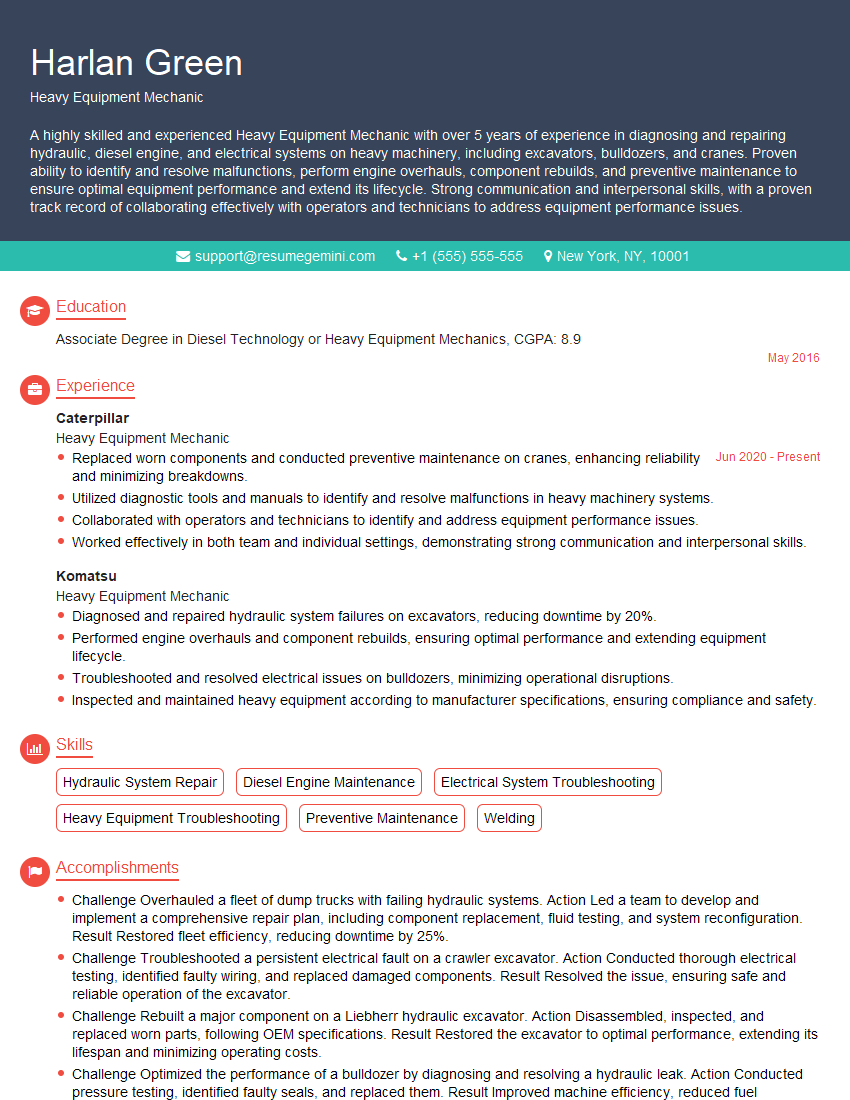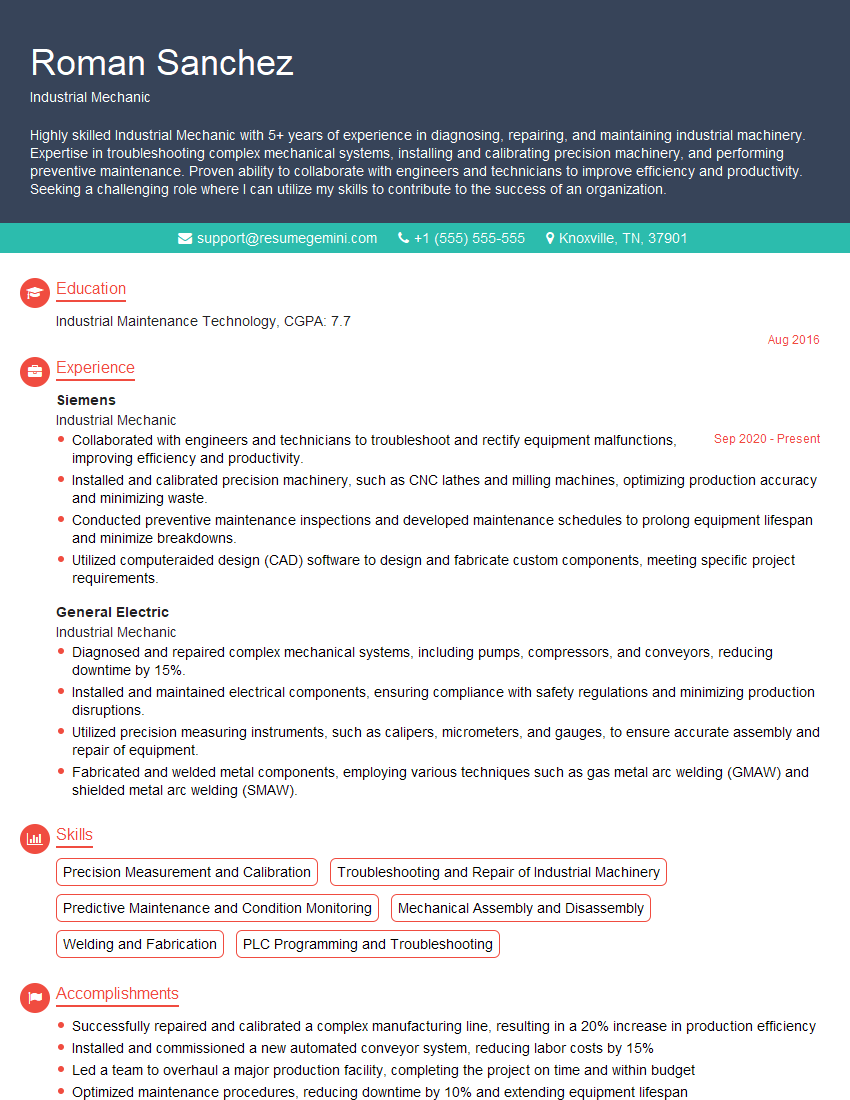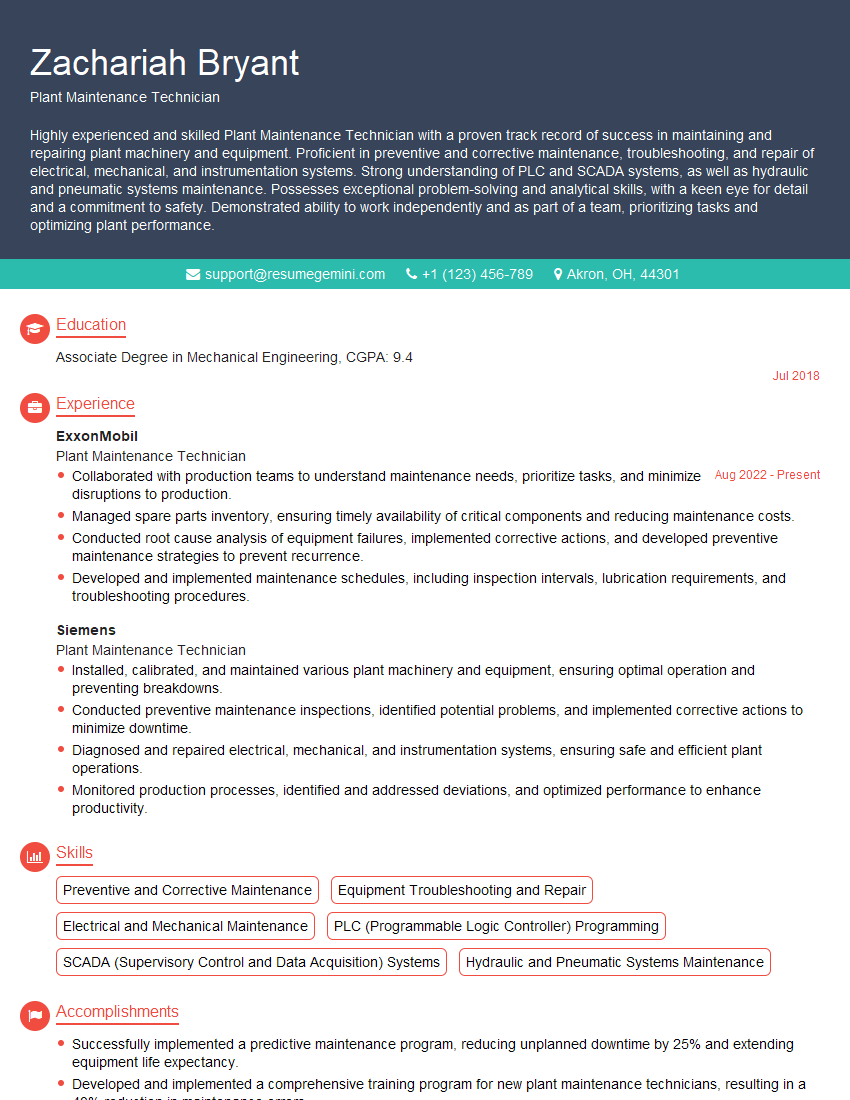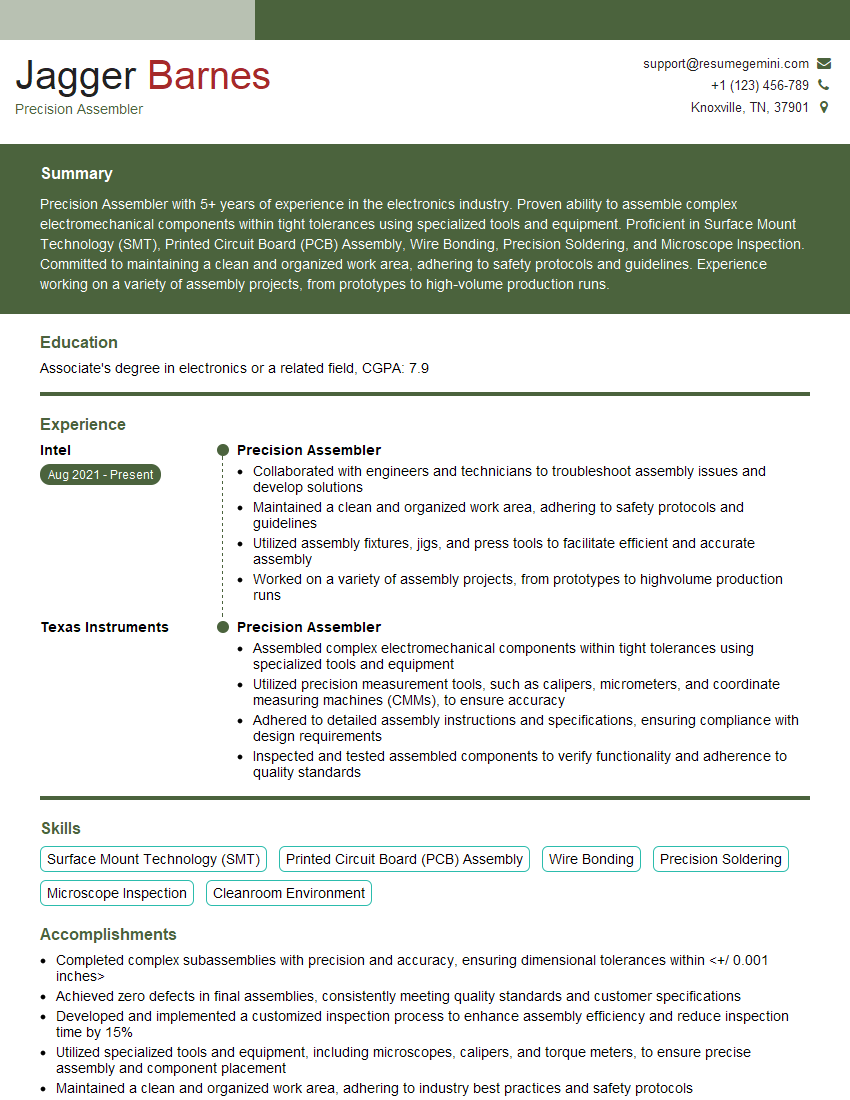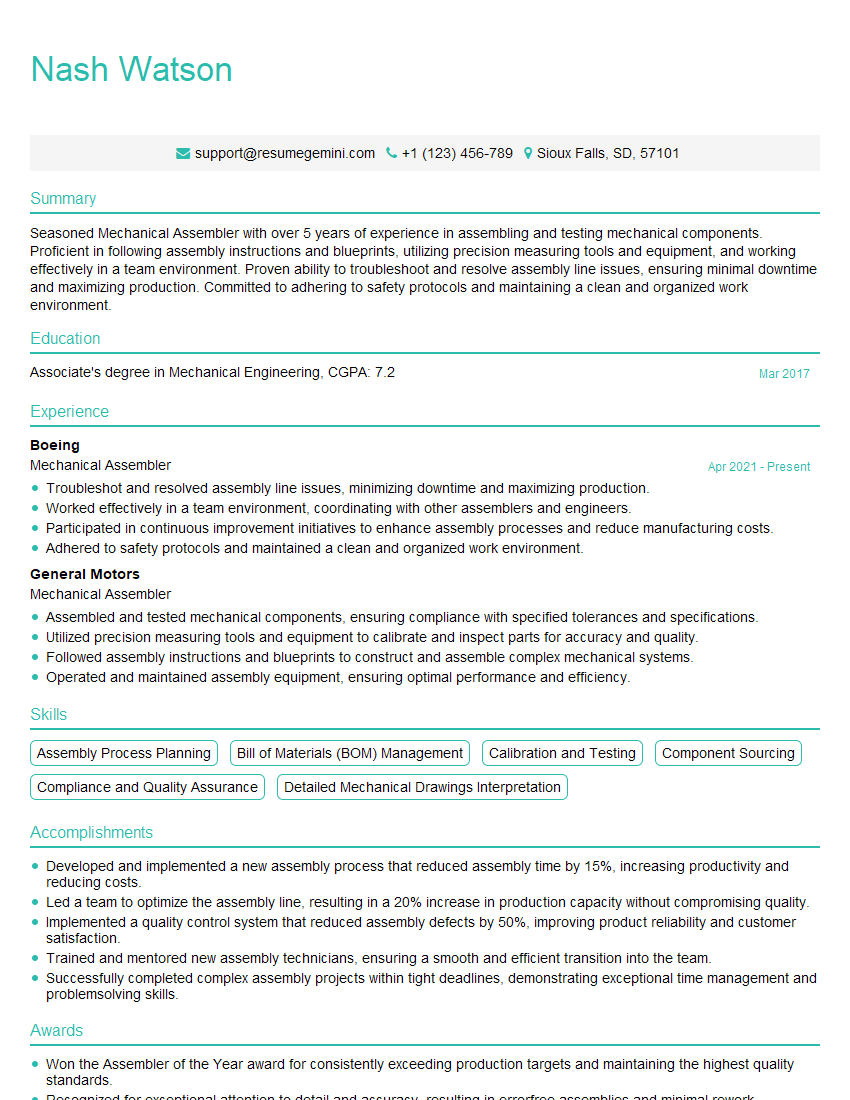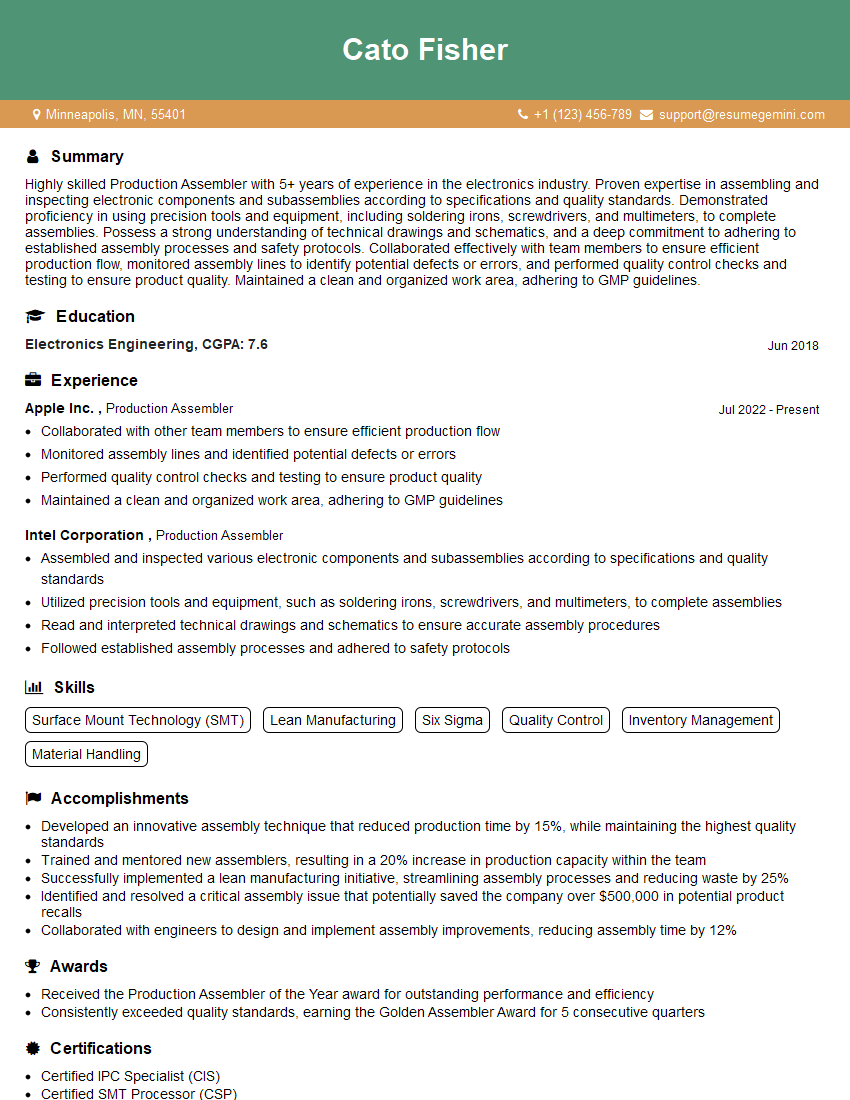Interviews are more than just a Q&A session—they’re a chance to prove your worth. This blog dives into essential Assembly and Disassembly of Industrial Machinery interview questions and expert tips to help you align your answers with what hiring managers are looking for. Start preparing to shine!
Questions Asked in Assembly and Disassembly of Industrial Machinery Interview
Q 1. Describe your experience with different types of fasteners.
My experience with fasteners spans a wide range, encompassing various types crucial for industrial machinery assembly. I’m proficient with bolts (from standard hex-head to specialized high-strength varieties), screws (machine screws, self-tapping screws, etc.), nuts (hex, cap, wing, etc.), rivets, pins (cotter pins, dowel pins, etc.), and even specialized fasteners like studs and keyways. Understanding the material properties (e.g., steel, stainless steel, aluminum) and thread types (e.g., metric, UNC, UNF) is critical for selecting the right fastener for the specific application and ensuring structural integrity. For instance, in assembling a high-pressure hydraulic system, I’d prioritize high-strength stainless steel bolts with appropriate thread locking compounds to prevent loosening under vibration.
- Example 1: Selecting between a grade 8.8 bolt and a grade 10.9 bolt for a critical connection, understanding the tensile strength implications for each.
- Example 2: Identifying the correct size and type of rivet for joining thin sheet metal components, considering shear strength and material compatibility.
Q 2. Explain the importance of torque specifications during assembly.
Accurate torque specifications are paramount during assembly, ensuring optimal clamping force without over-tightening or under-tightening. Over-tightening can cause fastener failure, stripping of threads, or damage to components. Under-tightening leads to insufficient clamping force, resulting in leaks, vibrations, or component misalignment. We use torque wrenches calibrated regularly, selecting the appropriate wrench based on the fastener size and required torque. The torque values are usually specified in engineering drawings or manufacturer’s manuals. I always double-check the specifications before proceeding. Think of it like baking a cake – you need the precise amount of each ingredient for optimal results. Similarly, in industrial assembly, the precise torque ensures the reliable and safe operation of the machinery.
Example: In assembling a gearbox, the torque specifications for each bolt securing the bearing housing are critical to prevent bearing damage or misalignment. Applying too much torque can crush the bearing, while applying too little can lead to premature wear and failure.
Q 3. How do you identify and address misaligned components during assembly?
Identifying misaligned components often involves a combination of visual inspection, precise measurement, and the use of alignment tools. We use dial indicators, laser alignment systems, and straight edges to detect even minute deviations. For instance, when assembling a pump and motor, alignment is critical to prevent premature wear on the shaft seals and bearings. Addressing misalignment might involve shimming (adding thin metal spacers), adjusting mounting feet, or machining parts to ensure accurate alignment. It’s a systematic process starting with identifying the source of the misalignment and then employing corrective measures to rectify it.
- Step 1: Identify the misalignment using appropriate tools (dial indicator, laser alignment system).
- Step 2: Determine the magnitude and direction of the misalignment.
- Step 3: Implement corrective measures (shimming, adjusting mounting points, machining).
- Step 4: Re-check alignment and repeat steps as necessary.
Q 4. What safety precautions do you follow during disassembly?
Safety is my top priority during disassembly. I always start by isolating the power source (electrical, hydraulic, pneumatic) completely before beginning any work. I utilize lockout/tagout procedures to prevent accidental activation. I wear appropriate personal protective equipment (PPE), including safety glasses, gloves, hearing protection (especially when working with pneumatic tools), and steel-toe boots. I take extra precautions when handling components under pressure or containing hazardous materials. I work methodically, removing fasteners one by one and documenting each step, avoiding unnecessary force to prevent damage or injury. Before handling components with stored energy (e.g., springs, compressed air tanks), I ensure that such energy is released safely.
Example: Before disassembling a hydraulic press, I would isolate the hydraulic power unit, release any pressure, and then proceed with the disassembly using appropriate tools and safety measures.
Q 5. Explain your process for documenting disassembly steps.
My disassembly documentation process is thorough and systematic. I typically use a combination of digital photography, detailed sketches (hand-drawn or CAD), and written notes. Photographs capture the overall assembly and the position of each component. Sketches provide a visual representation of the disassembly sequence, highlighting the location of fasteners and critical connections. Detailed notes include component numbers, torque specifications (if applicable), and any unique observations about the assembly. All this information is stored in a centralized location (usually a shared drive or a company database) for easy access and future reference. This documentation is essential for reassembly, troubleshooting, and providing a detailed record for maintenance purposes. It also helps prevent potential errors during reassembly.
Q 6. How do you handle unexpected issues during assembly or disassembly?
Handling unexpected issues during assembly or disassembly requires a methodical approach. First, I assess the situation to understand the nature of the problem. This involves careful observation and documentation (photos, notes). Next, I consult the relevant technical documentation (manuals, drawings) to see if the issue is addressed. If not, I consult with senior technicians or engineers to determine the best course of action. This might involve modifying the procedure, obtaining specialized tools, or ordering replacement parts. The key is to stay calm, carefully document the problem and corrective actions, and prioritize safety above all else. Learning from unexpected issues is crucial to improve future processes and avoid similar problems in the future.
Example: If a bolt snaps during disassembly, I would thoroughly document the failure, carefully remove the broken bolt segment (preventing further damage), and investigate the potential cause (incorrect torque, material fatigue). Then, I’d order a replacement bolt of the correct specification and ensure the proper installation procedure is followed during reassembly.
Q 7. Describe your experience with hydraulic and pneumatic systems.
I have extensive experience with both hydraulic and pneumatic systems in industrial machinery. My expertise includes understanding the principles of fluid power, component identification (pumps, valves, cylinders, actuators), troubleshooting system malfunctions, and performing maintenance tasks. With hydraulic systems, I’m familiar with various types of pumps (gear, vane, piston), valves (directional control, pressure control, flow control), and actuators (linear cylinders, hydraulic motors). Similarly, with pneumatic systems, I have experience working with air compressors, pneumatic valves, air cylinders, and related components. I understand safety protocols associated with high-pressure systems, and I’m proficient in using diagnostic tools such as pressure gauges and flow meters to identify and rectify leaks or malfunctions.
Example: I’ve successfully diagnosed and repaired a faulty hydraulic cylinder in a press machine by identifying a leak in the piston seal, ordering a replacement seal, and performing the repair following the manufacturer’s guidelines. In a pneumatic system, I have experience troubleshooting faulty valves by checking air pressure and signal inputs to the valve and identifying whether the problem is mechanical, electrical, or pneumatic in origin.
Q 8. Explain your understanding of different types of bearings.
Bearings are crucial components in industrial machinery, reducing friction and enabling smooth rotation. Different types are chosen based on load, speed, and operating conditions. Common types include:
- Ball Bearings: Use rolling balls to separate moving surfaces. Ideal for high-speed applications with lower radial loads. Think of a bicycle wheel – that’s a ball bearing.
- Roller Bearings: Employ cylindrical or tapered rollers, handling higher radial loads than ball bearings. These are frequently used in heavy-duty machinery like conveyor systems.
- Thrust Bearings: Designed to primarily handle axial loads (forces pushing along the shaft axis). Think of a propeller – the thrust bearing keeps it aligned.
- Tapered Roller Bearings: Combine radial and axial load-carrying capabilities. Common in automotive transmissions and other high-stress applications where both types of force are present.
- Sleeve Bearings (Journal Bearings): Utilize a lubricated sleeve to reduce friction between a rotating shaft and a housing. These are often found in slower-speed, high-load situations like large pumps.
Selecting the appropriate bearing type is critical for machine longevity and performance. Incorrect selection can lead to premature wear, failure, and costly downtime.
Q 9. How do you ensure proper lubrication during assembly?
Proper lubrication is paramount during assembly to prevent premature wear and ensure smooth operation. My approach involves:
- Selecting the Right Lubricant: This depends on the bearing type, operating temperature, and the load. Using the wrong lubricant can be detrimental – too thick and it restricts movement; too thin and it offers insufficient protection.
- Applying Lubricant Correctly: This often involves using a grease gun for bearings or dripping oil onto specific points as indicated in the machine’s manual. Over-lubrication can be as damaging as under-lubrication, leading to leakage and contamination.
- Ensuring Proper Distribution: I often rotate components slightly while applying lubricant to ensure even distribution within the bearing. This minimizes uneven wear and extends its lifespan.
- Checking for Leaks: After initial assembly and operation, I check for any lubricant leaks and address them immediately. This may involve replacing seals or tightening fittings.
I always refer to the manufacturer’s recommendations for specific lubricant types and quantities to avoid damaging the equipment.
Q 10. What are your methods for cleaning parts before reassembly?
Thorough cleaning of parts before reassembly is critical for preventing contamination and ensuring proper functionality. My methods include:
- Visual Inspection: Initial assessment to identify the extent of contamination and damage.
- Parts Washing: This can involve ultrasonic cleaning for intricate components or pressure washing for larger parts, using appropriate solvents such as degreasers to remove oils, grease, and other contaminants. I always ensure proper disposal of hazardous waste.
- Compressed Air Drying: After washing, I use compressed air to thoroughly dry all parts, ensuring no moisture remains. Residual moisture can lead to corrosion and rust.
- Inspection After Cleaning: A final visual inspection to ensure all contaminants have been removed and there’s no residual damage.
I always use appropriate Personal Protective Equipment (PPE), such as gloves and safety glasses, throughout the cleaning process.
Q 11. Describe your experience with using specialized tools (e.g., torque wrenches, dial indicators).
I have extensive experience using specialized tools essential for precision assembly and disassembly. For example:
- Torque Wrenches: Essential for tightening bolts and nuts to the manufacturer’s specified torque. Over-tightening can damage threads or components; under-tightening can lead to looseness and failure. I consistently calibrate my torque wrenches to ensure accuracy.
- Dial Indicators: Used for precise measurements of runout, alignment, and parallelism. This is crucial for ensuring proper shaft rotation and preventing vibrations. For instance, I’d use a dial indicator to check the alignment of a rotor on a motor shaft before final assembly.
- Pullers and Extractors: Used for safely removing bearings, gears, and other components without causing damage. Improper removal can easily damage expensive parts.
My proficiency with these tools guarantees accurate assembly, minimizing the risk of component damage and equipment malfunction.
Q 12. Explain your experience with different types of welding or joining techniques.
My experience encompasses various welding and joining techniques, selected based on material properties and application requirements:
- MIG (Metal Inert Gas) Welding: Widely used for its versatility and speed, particularly with ferrous metals. I often use it in fabrication work when repairing or building components.
- TIG (Tungsten Inert Gas) Welding: Known for producing high-quality, precise welds, suitable for thin materials and applications requiring aesthetic appeal. Excellent for stainless steel components.
- Arc Welding (SMAW – Shielded Metal Arc Welding): A robust method, often used for heavier materials, especially in outdoor or less-controlled environments.
- Bolting and Threading: For non-destructive joining, especially when disassembly may be required. I use various lock washers and appropriate bolt torques to ensure a secure joint.
I always adhere to safety protocols when using any welding equipment, including wearing appropriate PPE, maintaining proper ventilation, and ensuring proper grounding.
Q 13. How do you handle damaged or worn components during disassembly?
When encountering damaged or worn components during disassembly, my procedure involves:
- Documentation: Thorough documentation of the damage, including photos and notes. This aids in diagnosis of the root cause of failure and replacement ordering.
- Component Identification: Accurate identification of the damaged part using part numbers and specifications.
- Assessment of Damage: Determining the extent of damage – is repair feasible or is replacement necessary?
- Repair vs. Replacement: Repair may be cost-effective for minor damage, but extensive damage often necessitates replacement with a new component. I carefully weigh the costs and benefits.
- Ordering Replacement Parts: If replacement is necessary, I ensure the correct parts are ordered from reliable sources to maintain original specifications.
My experience helps me efficiently assess the situation and make informed decisions about repair or replacement, minimizing downtime.
Q 14. Explain your process for organizing and storing disassembled parts.
Organized storage of disassembled parts is crucial to avoid loss, confusion, and damage. My process involves:
- Component Tagging: Each component is clearly tagged with its part number, location within the machine, and any relevant notes about its condition.
- Categorization and Organization: Parts are categorized and placed in labeled containers or trays, maintaining their relative position within the machine for easy reassembly. I often use a parts list to confirm I have everything.
- Protection Against Damage: Parts are protected from damage using appropriate materials, such as bubble wrap, foam inserts, and desiccant packets to prevent rust.
- Storage Location: Parts are stored in a clean, dry, and secure location, away from dust, moisture, and potential damage.
This systematic approach guarantees efficient reassembly and minimizes the risk of errors or misplacement during the reassembly process.
Q 15. How do you verify the proper functionality of an assembled machine?
Verifying the proper functionality of an assembled machine is a crucial step, ensuring both safety and efficiency. It involves a multi-stage process, starting with a visual inspection for any obvious defects, loose connections, or misalignments. Think of it like building a house – you wouldn’t move in without checking the plumbing, electricity, and structural integrity.
Next, we conduct functional tests, tailored to the specific machine. This might involve running the machine through its typical operating cycle, monitoring key parameters like temperature, pressure, and vibration using specialized instruments. For instance, if it’s a conveyor belt, we’d test its speed, load-bearing capacity, and the reliability of its control system. Any deviation from the expected performance would trigger a more in-depth investigation.
Finally, we carry out performance testing under various conditions to ensure consistent operation. This is especially crucial in industrial environments where conditions can fluctuate (temperature, humidity etc.). We would record the data and compare it against pre-defined specifications, making any necessary adjustments. If everything aligns with expectations and safety protocols are met, only then do we give the machine a final sign-off.
Career Expert Tips:
- Ace those interviews! Prepare effectively by reviewing the Top 50 Most Common Interview Questions on ResumeGemini.
- Navigate your job search with confidence! Explore a wide range of Career Tips on ResumeGemini. Learn about common challenges and recommendations to overcome them.
- Craft the perfect resume! Master the Art of Resume Writing with ResumeGemini’s guide. Showcase your unique qualifications and achievements effectively.
- Don’t miss out on holiday savings! Build your dream resume with ResumeGemini’s ATS optimized templates.
Q 16. Describe your experience with troubleshooting mechanical issues.
Troubleshooting mechanical issues requires a systematic approach. I always start by carefully examining the problem, gathering as much information as possible. This involves observing the machine’s behavior, listening for unusual sounds, checking for visible signs of damage, and reviewing operational logs. It’s like detective work – you need to collect clues.
Once I’ve identified the potential source of the problem, I’ll utilize various diagnostic tools, including multimeters, vibration analyzers, and thermal cameras, to pinpoint the exact issue. For example, unusual vibrations might indicate a bearing failure, while high temperatures could point to an electrical short circuit.
My experience includes resolving issues ranging from simple component replacements (like replacing a worn-out gear) to more complex problems involving hydraulic system leaks or control system malfunctions. I’m adept at using both preventative maintenance schedules and reactive troubleshooting techniques to keep machinery functioning optimally. In one instance, a recurring shutdown of a packaging machine was traced to a faulty sensor triggering a false emergency stop. Replacing the sensor quickly restored full production.
Q 17. How familiar are you with technical drawings and schematics?
I’m highly proficient in interpreting technical drawings and schematics. They are essential for understanding a machine’s design, assembly, and operation. Think of them as the machine’s blueprint. I can confidently read and understand various types of drawings, including isometric, orthographic, and exploded views. I can also interpret electrical schematics, hydraulic diagrams, and pneumatic circuit diagrams, which are essential for understanding the complex interactions within a machine.
My experience with these drawings ranges from using them to guide assembly and disassembly to troubleshooting problems. The ability to interpret cross-sectional views or understand the flow of fluids in a hydraulic system, for instance, is critical for efficient problem-solving. I’m comfortable using CAD software to review and manipulate drawings as needed.
Q 18. Explain your experience working with different types of materials (e.g., metals, plastics, composites).
My experience encompasses a wide range of materials commonly used in industrial machinery. I’m comfortable working with various metals such as steel, aluminum, and stainless steel, each possessing different properties affecting their machining and handling. For example, stainless steel’s corrosion resistance requires specific welding techniques compared to mild steel.
I also have experience with different types of plastics, such as ABS, polycarbonate, and nylon, understanding their varying strengths, flexibility, and temperature tolerances. The selection of a plastic depends greatly on the application. For example, a high-impact plastic is needed for parts that might take heavy impacts. Finally, I’m familiar with composite materials, such as fiberglass-reinforced polymers, understanding their unique strength-to-weight ratios and their applications in specific machinery components. Choosing the right material is crucial for ensuring durability and performance.
Q 19. How do you prioritize tasks during assembly or disassembly?
Task prioritization during assembly or disassembly is crucial for efficiency and safety. I typically employ a combination of methods. First, I thoroughly review the work order or assembly instructions, breaking down the task into smaller, manageable steps. I then identify any critical path dependencies—steps that must be completed before others can begin. This is like planning a road trip – some things need to be done before others.
Safety is always paramount. Therefore, tasks involving potential hazards are always prioritized, ensuring all safety precautions are in place. I also consider the complexity of each task and allocate time accordingly, prioritizing those steps with a higher potential for error. Time management is essential to complete the project on schedule. This structured approach enables me to complete the job effectively and safely.
Q 20. Describe your experience with working from detailed work orders or instructions.
I have extensive experience working from detailed work orders and instructions. I consider these documents the roadmap for completing a task accurately and efficiently. I always meticulously review the instructions before starting any work, paying close attention to specifications, safety precautions, and any unique requirements. I see these as a critical tool for preventing mistakes and ensure that the finished product meets the exact specifications.
My experience includes working with both digital and hardcopy instructions, using various software for accessing and managing these documents. If any ambiguities or inconsistencies arise, I promptly seek clarification from supervisors or engineering staff to ensure everything is understood clearly. Clear communication is key to avoid costly mistakes. One project involved assembling a complex robotic arm using very detailed schematics, and meticulous following of the work order ensured a successful assembly.
Q 21. Explain your understanding of preventative maintenance.
Preventative maintenance (PM) is proactive upkeep designed to minimize downtime and extend the lifespan of machinery. It’s significantly more cost-effective than reactive repairs. Think of it as regular check-ups for your car – it’s cheaper to change the oil regularly than to replace the engine.
A comprehensive PM program involves regular inspections, lubrication, cleaning, and component replacements based on scheduled intervals or usage metrics. This can range from checking the oil level in a motor, adjusting belts, or inspecting for wear and tear, to more involved tasks such as checking for corrosion or replacing critical components. The schedule is often tailored to the specific machine and its operating environment. For example, machines in harsh environments might require more frequent maintenance. Proper documentation of PM activities is essential to track the machine’s health and to make informed decisions about future maintenance.
Q 22. How do you manage your time effectively during complex assembly projects?
Effective time management on complex assembly projects hinges on meticulous planning and proactive problem-solving. I approach these projects by first breaking down the entire assembly into smaller, manageable tasks. This involves carefully studying the schematics, parts lists, and any available assembly manuals. I then create a detailed schedule, prioritizing tasks based on dependencies and critical path analysis. Think of it like building a house – you wouldn’t start painting before the walls are up! For example, on a recent project involving a large conveyor system, I prioritized the assembly of the main frame before tackling the smaller components like sensors and motors. This phased approach avoids bottlenecks and ensures a smooth workflow.
Throughout the project, I regularly review progress against the schedule, identifying potential delays or challenges early on. Regular communication with the team, including daily stand-up meetings, helps to keep everyone informed and allows us to quickly address any issues that arise. Unexpected problems are addressed using a structured approach, involving documenting the issue, exploring potential solutions, selecting the best option, and documenting the resolution for future reference. Finally, consistent tracking of progress, using tools like Gantt charts, allows me to adjust the schedule as necessary and stay on track.
Q 23. What is your experience with using Computerized Maintenance Management Systems (CMMS)?
I have extensive experience using Computerized Maintenance Management Systems (CMMS), specifically [mention specific CMMS software used, e.g., SAP PM, Maximo, or similar]. My experience spans from data entry and work order management to generating reports and analyzing maintenance trends. I utilize CMMS to track parts inventory, schedule preventative maintenance, manage work orders, and monitor equipment performance. For example, using the CMMS, I’ve identified recurring issues with a particular component in a packaging machine leading to proactive replacement scheduling and preventing costly downtime. The ability to generate insightful reports using the CMMS allows us to analyze maintenance costs, identify patterns of failure, and ultimately optimize our maintenance strategies for maximum efficiency and minimal disruption.
Q 24. Describe your experience with safety protocols and lockout/tagout procedures.
Safety is paramount in my work. I have a comprehensive understanding of, and strict adherence to, all relevant safety protocols, particularly lockout/tagout (LOTO) procedures. LOTO is a critical safety procedure used to prevent the unexpected energization or startup of machinery during maintenance or repair. Before commencing any work on machinery, I always follow a rigorous LOTO procedure, which involves identifying all energy sources (electrical, hydraulic, pneumatic, etc.), isolating them, applying appropriate lockout devices, and verifying the absence of energy before beginning work. It’s not just about following steps; it’s about understanding the *why* behind each step – ensuring that no one gets hurt.
I’ve personally witnessed the importance of LOTO during a maintenance project on a high-speed press. By adhering to strict LOTO procedures, we were able to safely perform maintenance without any incidents. I also participate regularly in safety training and refresher courses to stay current on best practices and updated regulations.
Q 25. How do you ensure compliance with relevant safety regulations?
Compliance with safety regulations is not just a checklist; it’s an integral part of my work ethic. I familiarize myself with all relevant OSHA (or equivalent in your location) regulations and industry-specific standards before undertaking any project. This often involves reviewing safety data sheets (SDS) for all materials and equipment used. For example, when working with hydraulic systems, understanding the hazards associated with high-pressure fluids and using appropriate safety measures is critical. I proactively identify potential hazards and implement control measures, documenting these in risk assessments. Regular audits and safety meetings are crucial in maintaining compliance and promoting a safe work environment. I always encourage my colleagues to raise safety concerns without hesitation, fostering a culture of safety where everyone feels responsible.
Q 26. What steps do you take to ensure the quality of your work?
Ensuring the quality of my work involves a multifaceted approach. Firstly, I meticulously follow assembly instructions and blueprints, paying close attention to details. Secondly, I employ rigorous quality control checks at each stage of the assembly process. This includes visual inspections, dimensional checks using calibrated tools, and functional tests to verify proper operation. For example, when assembling a robotic arm, I verify each joint’s movement range and accuracy. Moreover, I use precision instruments, maintain a clean and organized workspace, and document all work performed. This documentation serves as a record for troubleshooting, future maintenance, and demonstrating compliance with quality standards. Lastly, I welcome feedback and am open to constructive criticism to continuously improve my skills and the quality of my work. Quality isn’t just about meeting minimum standards; it’s about exceeding expectations and building something reliable and durable.
Q 27. Describe your experience with working in a team environment.
I thrive in team environments. Effective teamwork, to me, is about clear communication, mutual respect, and shared responsibility. I believe in actively contributing to team discussions, offering my expertise while also being receptive to other team members’ ideas. On numerous occasions, I’ve collaborated with electricians, programmers, and other technicians to successfully commission complex machinery. A recent example involved a large-scale automation project. By working closely with a team of engineers and technicians, we successfully integrated a new robotic system into an existing production line ahead of schedule and within budget. Open communication and effective collaboration played a significant role in this achievement. I feel that my strong communication and problem-solving skills, coupled with my ability to listen and learn from others, enhance team dynamics.
Q 28. How do you stay up-to-date on the latest industry standards and technologies?
Staying current in this rapidly evolving field is essential. I achieve this through various means. I regularly attend industry conferences and workshops to learn about the latest technologies and best practices. I actively participate in professional organizations, such as [mention relevant professional organizations], and engage in networking opportunities. Furthermore, I subscribe to industry publications, both print and online, and actively seek out webinars and online courses. Finally, I leverage my own professional network to stay informed about advancements in my field. Continuously learning helps me adapt to new challenges and enhance my skills – it’s the only way to remain a truly effective and valuable asset in the ever-changing landscape of industrial machinery assembly and disassembly.
Key Topics to Learn for Assembly and Disassembly of Industrial Machinery Interview
- Safety Procedures and Regulations: Understanding and adhering to safety protocols, including lockout/tagout procedures, use of personal protective equipment (PPE), and hazard identification.
- Tools and Equipment: Familiarity with various hand tools, power tools, and specialized equipment used in assembly and disassembly, including their proper operation and maintenance.
- Blueprint Reading and Technical Drawings: Ability to interpret schematics, diagrams, and technical manuals to understand the machine’s components and assembly sequence.
- Component Identification and Functionality: Knowledge of individual parts, their function within the machine, and how they interact with other components.
- Sequential Assembly and Disassembly: Understanding the logical steps involved in both assembling and disassembling the machinery, including proper torque specifications and alignment.
- Troubleshooting and Problem-Solving: Identifying and resolving common issues during assembly or disassembly, such as misaligned parts, damaged components, or incorrect procedures.
- Maintenance and Repair Procedures: Familiarity with routine maintenance tasks, identifying potential wear and tear, and performing basic repairs.
- Hydraulic and Pneumatic Systems: Understanding the principles of hydraulic and pneumatic systems commonly found in industrial machinery, and their role in operation.
- Electrical Systems (if applicable): Basic knowledge of electrical components, wiring diagrams, and safety precautions related to electrical systems within the machinery.
- Quality Control and Inspection: Performing quality checks at various stages of assembly and disassembly to ensure proper functionality and adherence to specifications.
Next Steps
Mastering the assembly and disassembly of industrial machinery is crucial for career advancement in numerous manufacturing and industrial settings. It demonstrates a valuable skillset that employers highly prize, opening doors to specialized roles and higher earning potential. To maximize your job prospects, creating an ATS-friendly resume is essential. This ensures your application gets noticed by recruiters and hiring managers. We recommend using ResumeGemini, a trusted resource for building professional and effective resumes. ResumeGemini provides examples of resumes tailored to Assembly and Disassembly of Industrial Machinery to help you craft a winning application.
Explore more articles
Users Rating of Our Blogs
Share Your Experience
We value your feedback! Please rate our content and share your thoughts (optional).
What Readers Say About Our Blog
There are no reviews yet. Be the first one to write one.




